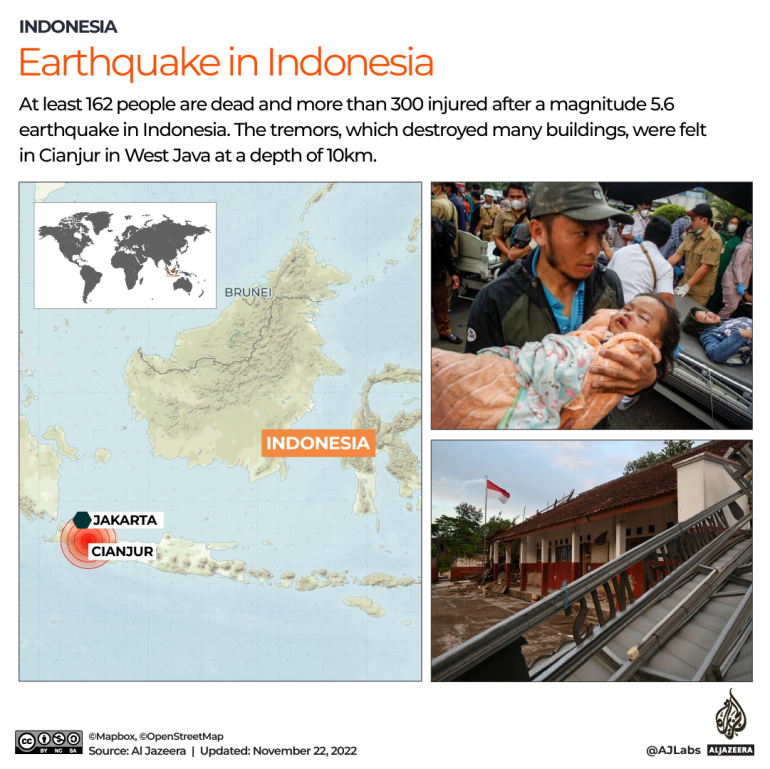Indonesian rescue workers race to find survivors after Java quake
Death toll is likely to rise as rescue efforts continue after Monday’s 5.6 magnitude earthquake in west of Java island.

Rescue workers in Indonesia are racing to reach people still trapped in rubble a day after an earthquake devastated a West Java town, killing and injuring hundreds of people as buildings collapsed.
Dedi Prasetyo, a police spokesman, told the Antara news agency on Tuesday that hundreds of police officers were joining rescue efforts in the town of Cianjur, closest to the epicentre of the the shallow 5.6-magnitude quake.
Keep reading
list of 4 itemsDeath toll in Indonesia quake rises to 162, hundreds injured
Indonesia’s Widodo calls on G20 to work to ‘end the war’
‘Too late to save him’: Indonesian children killed by cough syrup
The town of 175,000 people is located in a mountainous area of West Java, Indonesia’s most densely-populated province.
“Today’s main task order for personnel is to focus on evacuating victims,” Prasetyo said.
The shallow temblor killed at least 268 people, many of them children, with 151 still missing, disaster relief officials said.
Disaster agency chief Suharyanto told reporters more than 1,000 people had been injured, 58,000 displaced, and 22,000 houses damaged.
Landslides and rough terrain hampered rescue efforts on Tuesday, said Henri Alfiandi, head of national search and rescue agency Basarnas.
“The challenge is the affected area is spread out… On top of that the roads in these villages are damaged,” Alfiandi told reporters.

Authorities were operating “under the assumption that the number of injured and death will rise with time”, West Java Governor Ridwan Kamil said.
Some of the dead were students at an Islamic boarding school while others were killed in their own homes when roofs and walls fell in on them.
“The room collapsed and my legs were buried under the rubble. It all happened so fast,” 14-year-old student Aprizal Mulyadi said. He said was pulled to safety by his friend, Zulfikar, who later died after getting trapped under rubble.
“I was devastated to see him like that, but I could not help him because my legs and back were injured,” he said.
Disaster officials said they would focus their efforts on an area that was struck by a landslide triggered by the quake.
Television news channels showed footage of people digging brown earth by hand using hoes, sticks, crowbars and other tools.
“At least six of my relatives are still unaccounted for, three adults and three children,” said Zainuddin, a resident.
“If it was just an earthquake only the houses would collapse, but this is worse because of the landslide. In this residential area there were eight houses, all of the which were buried and swept away.”
Overnight, a hospital car park in Cianjur was inundated with victims, some treated in makeshift tents, others hooked up to intravenous drips on the pavement, while medical workers stitched up patients under torchlight.
“Everything collapsed beneath me and I was crushed beneath this child,” Cucu, a 48-year-old resident who had gone to the hospital, told Reuters.
“Two of my kids survived, I dug them up … Two others I brought here, and one is still missing,” she said through tears.
Landslides, power cuts
Reporting from the Rumah Sakit Sayang hospital, Al Jazeera’s Jessica Washington said medical workers had been forced to treat patients in the building’s carpark because Monday’s tremor had left extensive cracks in its walls.
“Since our arrival in the early hours of the morning, we’ve heard the persistent sound of ambulance as health workers try to reach those in need,” she said.
“Many of the victims at this hospital are children with head injuries. Many of the children also have fractures and officials say dozens have died here.”
Save the Children Indonesia said it was deploying a team to Cianjur on Tuesday to assess the impact of the disaster and determine the needs of the children and adults affected. It is also preparing school tents, back-to-school kits, educational recreation kits, and family hygiene kits for distribution.
At SMP Junior High School 5, one of the schools with which Save the Children works in West Java, teacher Mia Saharosa said everyone was forced to evacuate during class.
“It was a shock to all of us as it occurred in the middle of the learning process … We all gathered in the field, children were terrified and cried, worried about their families at home. We hug each other, strengthen each other, and continue to pray,” she was quoted saying by the nongovernmental organisation in a statement.

![Survivors of West Java quake receive treatment in Cianjur in Indonesia [Jessica Washington/ Al Jazeera]](/wp-content/uploads/2022/11/2022_1122_10184800.jpg?w=770&resize=770%2C513)
The earthquake, felt strongly some 75km (45 miles) away in the capital Jakarta, damaged at least 2,200 homes. Some 13,000 people were taken to evacuation shelters, according to the governor.
At a shelter in Ciherang village near Cianjur, Nunung, a 37-year-old woman, said she had pulled herself and her 12-year-old son out of the rubble of their collapsed home.
“I screamed for help for nobody came to help us, I had to free ourselves by digging,” she told AFP, her face covered in dry blood.
“Nothing is left, there is nothing I could save but the clothes on our back.”
Rescue efforts have been complicated by electricity outages in some areas, and more than 80 aftershocks.
Straddling the so-called Ring of Fire, an active seismic zone where different plates on the earth’s crust meet, Indonesia has a history of devastating earthquakes and volcanic eruptions.
In September 2018, a 7.5 magnitude earthquake struck in shallow waters off the city of Palu in Sulawesi, triggering a tsunami, liquefaction and landslides that devastated the city and killed more than 4,000 people.
In December 2004, a 9.1 magnitude earthquake off Sumatra island in western Indonesia triggered a giant tsunami that swept ashore in 14 countries around the Indian Ocean, killing 226,000 people, more than half of them in Indonesia.